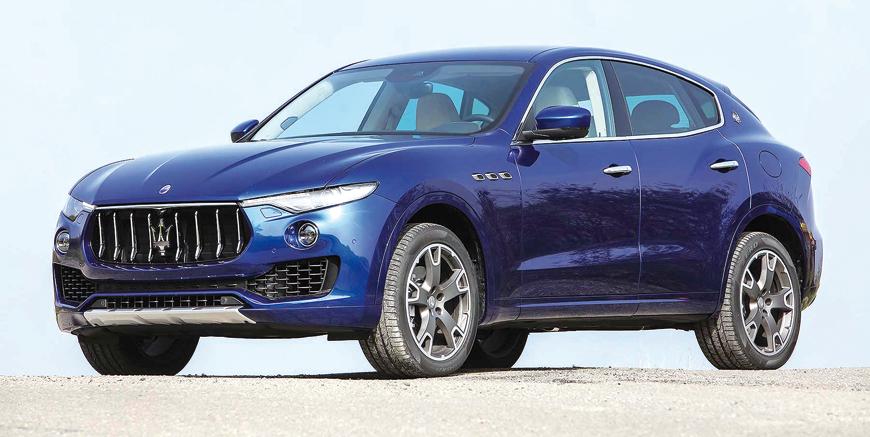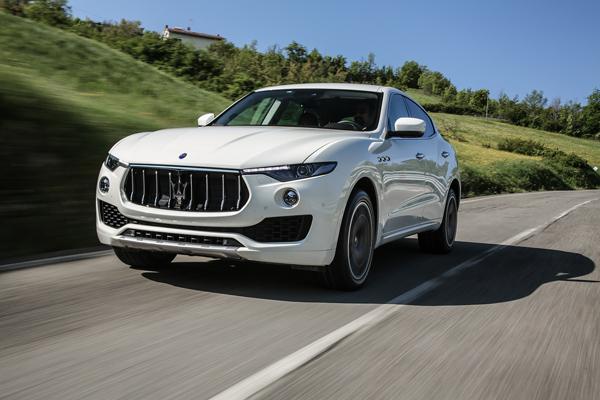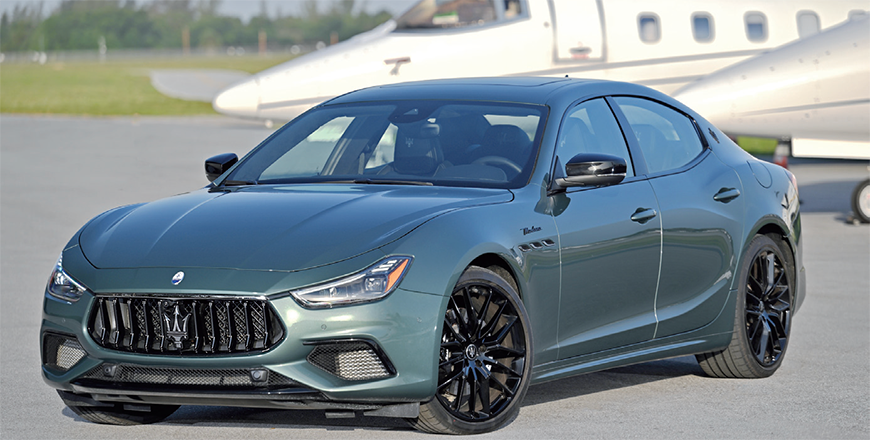You are here
Maserati Levante: Dramatic and dynamic SUV
By Ghaith Madadha - May 16,2016 - Last updated at May 16,2016

Photo courtesy of Maserati
Renowned as a maker of fine luxury and sports cars and with a rich racing tradition, Maserati now enter the SUV market with the long-awaited Levante SUV. Expected to drastically expand the brand’s sales and client demographic even more than its Ghibli mid-size executive saloon sister, the Maserati SUV should not come as a surprise, given the premium SUV market’s ever-growing popularity.
Unprecedented as a production model, the Maserati SUV has been in the pipeline since the Kubang concept first appeared as a crossover style vehicle in 2003 and was revisited as an SUV in 2011. Erroneously expected by some pundits to be a badge-engineered Jeep, the production Levante is however, and in fact, a smooth, refined and sporty SUV of distinctly Italian and Maserati provenance.
Predatory posture
Drawing heavily on the seductively dramatic 2014 Maserati Alfieri sports coupe concept, the Levante strike a similarly moody and assertively predatory aesthetic, all the more dominant owing to increased ride height. With vast hexagonal grille, squinting strongly browed headlights and a long sculpted bonnet with side ports to exaggerate its length, the Levante features slim inwardly tilted LED running lights, widely spaced grille slats and evocative Trident emblem.
Deep, gaping and hungry, the Levante’s grille reveals close radiator slats which help achieve best in class CD0.31 aerodynamics and can open to feed in cooling air when necessary. Kitted with enormous 265/45R20 footwear to fill its muscular wheelarches, the Levante’s rising waistline and descending roof lend urgency from profile, while broad haunches, pert rear section, big tailgate spoiler and big dual exhausts give it’s a sporting edge and road hugging demeanour.
Riding on air spring suspension for poised level cornering and comfort over imperfections, the Levante features five ride heights, including low parking and 175mm ground clearance high-speed modes where it looks hunkered down and aggressive. Off-road modes can raise clearance to stilt-like 247mm — from a default 210mm — to comfortably traverse deep ruts and rocks, improve approach, departure and ramp angles and increase wheel travel to keep tyres in contact with the ground.
Flexible and abundant
Built on a lighter and 20 per cent stiffer version of its Ghibli and Quattroporte saloon sisters’ architecture, the Levante also shares the same Ferrari-built 3-litre direct injection twin-turbo V6 engine and smooth. Driving all four wheels through a swift and slick 8-speed automatic gearbox, the Levante features different driving modes which alter gearbox and throttle responses and suspension firmness. Fixed steering column-mounted manual mode paddle shifters allow for more driver involvement.
Offered in two states of tune including a range-topping 424BHP Levante S, the driven base model is by no means short on power, punching out a mighty 345BHP at a relatively low-revving and easily accessible 5750rpm. With quick-spooling turbos virtually eliminating off-the-line turbo lag, the Levante pulls confidently hard from low-end and is characterised by a muscular 369lb/ft wall of torque throughout a broad and versatile 1750-500rpm.
Launching its 2109kg frame from standstill to 100km/h in just 6 seconds and capable of a 251km/h top speed, the Levante’s power accumulation is underwritten by an effortlessly flexible and wide mid-range wave of torque. Influencing one to exploit its burgeoning mid-range brawn rather than instinctively reach for top-end power like the S model, the entry-level Levante is confidently swift yet promotes a more relaxed approach, and return good in-class 10.7l/100km fuel efficiency.
Sure-footed and fluent
With sophisticated double wishbone front and five-link rear suspension combined with standard air suspension and Skyhook adaptive dampers, the Levante is able to dispatch road imperfections with supple stability and corners with sure-footed finesse. More forgiving rear anti-roll bar setting and slimmer rear tyres in the entry-level Levante — compared with the S model — make it a more compliant and fluent drive through winding mountain roads, feeding in lateral weight shifts in a more progressive manner.
Ostensibly driving with a rear-drive like balance and fluency, the Levante’s effective and low-position Q4 four-wheel drive system sends 100 per cent of its power rearwards under normal condition. However, pressed hard through a corner, the Levante’s electronically controlled wet multi-plate clutch can divert up to 50 per cent power to the front wheels to retain traction, grip and ensure safe, swift and confident cornering, while its light suspension keeps tyres flat and firmly gripping the road.
Additionally featuring a mechanical limited-slip rear differential to res-distribute power along the rear axle and an electronic torque vectoring that selectively brakes inside wheels through tight corners. The Levante is ever poised, controlled, agile and tenaciously sticks to tarmac through narrow switchbacks. Tidy into corners, the Levante features precise, light and natural feeling speed-sensitive hydraulic-assisted steering.
Stylish and spacious
Committed and reassuring at speed, the Levante is also unexpectedly capable off-road. Featuring pre-set off-road modes, the Lavante’s air suspension rises for additional clearance, while electronic stability and drive-line systems are recalibrated for various off-road conditions. On test drive over a challenging dirt and gravel route, the Levante dispatched the uneven low traction surfaces and steep inclines with ease. Meanwhile, a low-set front facing camera allows drivers to see terrain conditions more accurately than the Levante’s long and high bonnet would normally permit.
With ascending high waistline and descending roofline, the Levante’s cabin has a hunkered down profile, yet is spacious in front, and is surprisingly accommodating in the rear, where leg and headroom is noticeably better than most competitors. Highly adjustable seats and steering allow for a support and comfortable driving position, while layouts and design are elegant yet sporty, utilising quality materials.
Infotainment and convenience features are extensive and include heated/ventilated seats, climate control, pedal adjustment, optional rear electric sunblinds and panoramic sunroof and user-friendly high-resolution 8.4-inch touchscreen. High end Harmon Kardon and Bowers & Wilkins sound systems are available as are customisation options. Driver assistance systems are extensive and include stop/go adaptive cruise control, hill descent control, blind spot, lane departure and forward collision warnings, rear and surround view cameras and parking assistance.
TECHNICAL SPECIFICATIONS
Engine: 3-litre, in-line, twin-turbocharged V6 cylinders
Bore x stroke: 86.5 x 84.5mm
Compression: 9.7:1
Valve-train: Chain-driven 24-valve DOHC, direct injection, variable valve timing
Gearbox: 8-speed, automatic, four-wheel drive, self-locking rear-differential
Gear ratios: 1st 4.71; 2nd 3.14; 3rd 2.11; 4th 1.67; 5th 1.28; 6th 1.0; 7th 0.84; 8th 0.67
Reverse/final drive: 3.3/2.8
Power, BHP (PS) [kW]: 345 (350) [257] @5750rpm
Specific power: 115.8BHP/litre
Power-to-weight: 163.5BHP/tonne
Torque lb/ft (Nm): 369 (500) @1750-5000rpm
Specific torque: 167.8Nm/litre
Torque-to-weight: 237Nm/tonne
Redline: 6500rpm
0-100km/h: 6 seconds
Top speed: 251km/h
Fuel consumption, urban/extra-urban/combined: 14.8-/8.3-/10.7 litres/100km
CO2 emissions, combined: 249g/km
Fuel capacity: 80 litres
Length: 5003mm
Width: 1968mm
Height: 1679mm
Wheelbase: 3004mm
Track, F/R: 1624/1676mm
Kerb weight: 2109kg
Weight distribution F/R: 50:50
Luggage volume: 580 litres
Suspension, F/R: Double wishbone/multi-link, adjustable air springs
Brakes, F/R: Ventilated perforated discs, 345 x 32mm/330 x 22mm
Brake callipers, F/R: 2-/1-piston
Stopping distance, 100-0km/h: 36 metres
Turning circle: 11.7 metres
Tyres, F/R: 265/45R20 (as tested)
Related Articles
A long time in the making ever since the Italian manufacturer’s 2003 and 2011 Kubang concept SUVs, the Maserati Levante debuted back in 2016
Long-expected and first hinted at with the 2003 Kubang concept, Maserati’s first production SUV stormed onto global markets arrived earlier
Swimming alongside predominantly German cars in the mid-size executive segment, the shark-like Maserati Ghibli competes with traditional sal



















